ATM和ATR的信号传导通路综述
- 格式:docx
- 大小:15.82 KB
- 文档页数:3
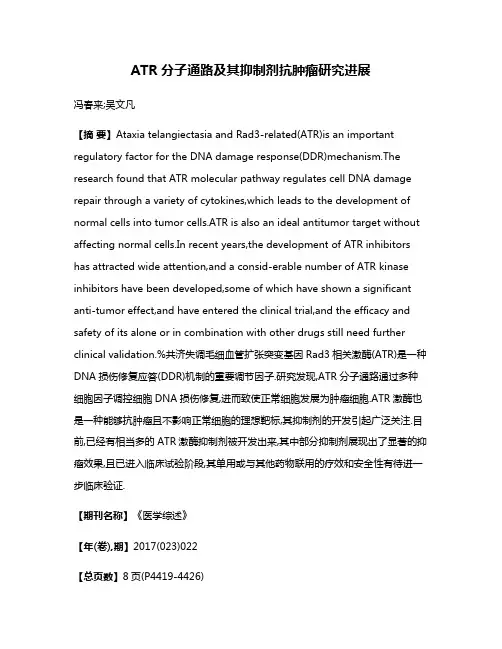
ATR分子通路及其抑制剂抗肿瘤研究进展冯春来;吴文凡【摘要】Ataxia telangiectasia and Rad3-related(ATR)is an important regulatory factor for the DNA damage response(DDR)mechanism.The research found that ATR molecular pathway regulates cell DNA damage repair through a variety of cytokines,which leads to the development of normal cells into tumor cells.ATR is also an ideal antitumor target without affecting normal cells.In recent years,the development of ATR inhibitors has attracted wide attention,and a consid-erable number of ATR kinase inhibitors have been developed,some of which have shown a significant anti-tumor effect,and have entered the clinical trial,and the efficacy and safety of its alone or in combination with other drugs still need further clinical validation.%共济失调毛细血管扩张突变基因Rad3相关激酶(ATR)是一种DNA损伤修复应答(DDR)机制的重要调节因子.研究发现,ATR分子通路通过多种细胞因子调控细胞DNA损伤修复,进而致使正常细胞发展为肿瘤细胞.ATR激酶也是一种能够抗肿瘤且不影响正常细胞的理想靶标,其抑制剂的开发引起广泛关注.目前,已经有相当多的ATR激酶抑制剂被开发出来,其中部分抑制剂展现出了显著的抑瘤效果,且已进入临床试验阶段,其单用或与其他药物联用的疗效和安全性有待进一步临床验证.【期刊名称】《医学综述》【年(卷),期】2017(023)022【总页数】8页(P4419-4426)【关键词】共济失调毛细血管扩张突变基因Rad3相关激酶分子通路;共济失调毛细血管扩张突变基因Rad3相关激酶抑制剂;肿瘤;靶点【作者】冯春来;吴文凡【作者单位】江苏大学药学院,江苏镇江212013;江苏大学药学院,江苏镇江212013【正文语种】中文【中图分类】R322DNA在外部环境和细胞内部的各种因素作用下可不断产生损伤,如体内代谢过程中产生的自由基、DNA在复制和重组过程中自发的错误、环境中的紫外线和离子辐射(ionizing radiation,IR)以及一些化学物质等均能引起DNA损伤,从而导致细胞死亡,有害突变影响细胞活力以及异常细胞行为[1]。
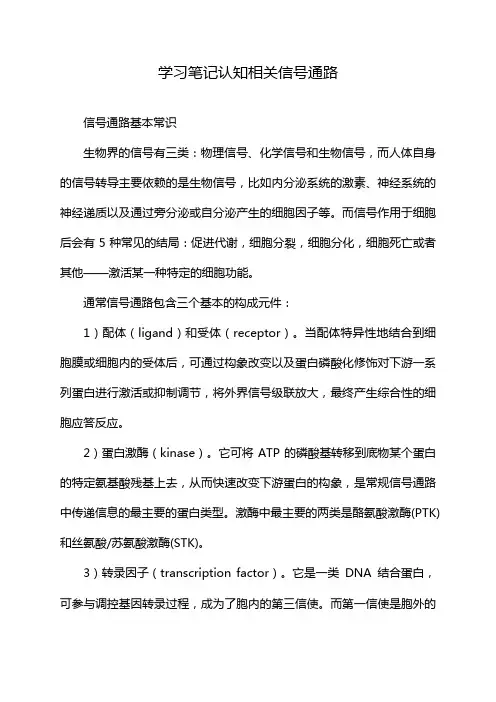
学习笔记认知相关信号通路
信号通路基本常识
生物界的信号有三类:物理信号、化学信号和生物信号,而人体自身的信号转导主要依赖的是生物信号,比如内分泌系统的激素、神经系统的神经递质以及通过旁分泌或自分泌产生的细胞因子等。
而信号作用于细胞后会有5种常见的结局:促进代谢,细胞分裂,细胞分化,细胞死亡或者其他——激活某一种特定的细胞功能。
通常信号通路包含三个基本的构成元件:
1)配体(ligand)和受体(receptor)。
当配体特异性地结合到细胞膜或细胞内的受体后,可通过构象改变以及蛋白磷酸化修饰对下游一系列蛋白进行激活或抑制调节,将外界信号级联放大,最终产生综合性的细胞应答反应。
2)蛋白激酶(kinase)。
它可将ATP的磷酸基转移到底物某个蛋白的特定氨基酸残基上去,从而快速改变下游蛋白的构象,是常规信号通路中传递信息的最主要的蛋白类型。
激酶中最主要的两类是酪氨酸激酶(PTK)和丝氨酸/苏氨酸激酶(STK)。
3)转录因子(transcription factor)。
它是一类DNA结合蛋白,可参与调控基因转录过程,成为了胞内的第三信使。
而第一信使是胞外的
配体,第二信使是配体受体结合后激活的胞内信号分子,如环磷腺苷(cAMP)、环磷鸟苷(cGMP)、Ca2+等,有助于信号向胞内进行传递。
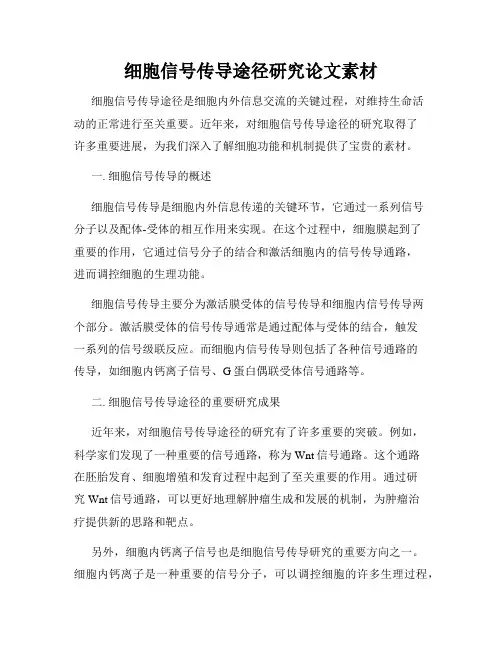
细胞信号传导途径研究论文素材细胞信号传导途径是细胞内外信息交流的关键过程,对维持生命活动的正常进行至关重要。
近年来,对细胞信号传导途径的研究取得了许多重要进展,为我们深入了解细胞功能和机制提供了宝贵的素材。
一. 细胞信号传导的概述细胞信号传导是细胞内外信息传递的关键环节,它通过一系列信号分子以及配体-受体的相互作用来实现。
在这个过程中,细胞膜起到了重要的作用,它通过信号分子的结合和激活细胞内的信号传导通路,进而调控细胞的生理功能。
细胞信号传导主要分为激活膜受体的信号传导和细胞内信号传导两个部分。
激活膜受体的信号传导通常是通过配体与受体的结合,触发一系列的信号级联反应。
而细胞内信号传导则包括了各种信号通路的传导,如细胞内钙离子信号、G蛋白偶联受体信号通路等。
二. 细胞信号传导途径的重要研究成果近年来,对细胞信号传导途径的研究有了许多重要的突破。
例如,科学家们发现了一种重要的信号通路,称为Wnt信号通路。
这个通路在胚胎发育、细胞增殖和发育过程中起到了至关重要的作用。
通过研究Wnt信号通路,可以更好地理解肿瘤生成和发展的机制,为肿瘤治疗提供新的思路和靶点。
另外,细胞内钙离子信号也是细胞信号传导研究的重要方向之一。
细胞内钙离子是一种重要的信号分子,可以调控细胞的许多生理过程,例如细胞的增殖、凋亡、分化等。
通过研究细胞内钙离子信号传导的途径,可以深入了解这些生理过程的调控机制,并为相关疾病的治疗提供新的思路。
三. 细胞信号传导途径的应用前景对细胞信号传导途径的研究不仅有助于我们深入了解细胞的机制,还有广泛的应用前景。
例如,通过干扰特定的信号通路,可以干预肿瘤细胞的生长和扩散,为肿瘤治疗提供新的策略。
同时,了解细胞信号传导途径的机制,也有助于我们开发新的药物和治疗方法,以应对其他相关疾病的挑战。
细胞信号传导途径研究的素材十分丰富多样,科学家们正积极开展相关研究,为我们揭示细胞信号传导的奥秘提供更多的线索。
相信在不久的将来,通过研究细胞信号传导途径,我们将能够更好地理解细胞的功能和机制,为生命科学领域的发展贡献更多的力量。
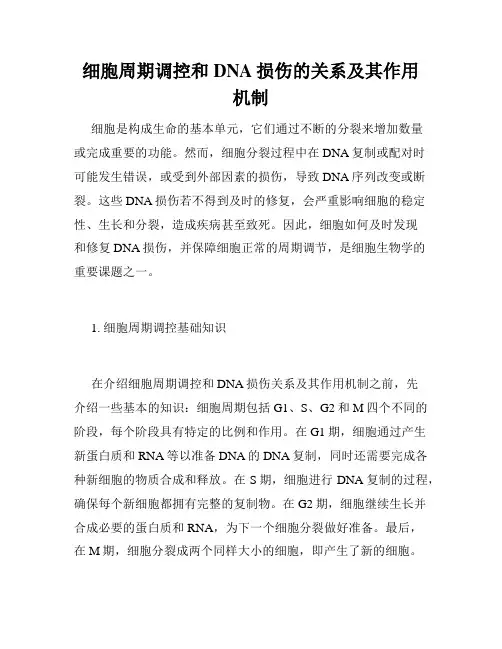
细胞周期调控和DNA损伤的关系及其作用机制细胞是构成生命的基本单元,它们通过不断的分裂来增加数量或完成重要的功能。
然而,细胞分裂过程中在DNA复制或配对时可能发生错误,或受到外部因素的损伤,导致DNA序列改变或断裂。
这些DNA损伤若不得到及时的修复,会严重影响细胞的稳定性、生长和分裂,造成疾病甚至致死。
因此,细胞如何及时发现和修复DNA损伤,并保障细胞正常的周期调节,是细胞生物学的重要课题之一。
1. 细胞周期调控基础知识在介绍细胞周期调控和DNA损伤关系及其作用机制之前,先介绍一些基本的知识:细胞周期包括G1、S、G2和M四个不同的阶段,每个阶段具有特定的比例和作用。
在G1期,细胞通过产生新蛋白质和RNA等以准备DNA的DNA复制,同时还需要完成各种新细胞的物质合成和释放。
在S期,细胞进行DNA复制的过程,确保每个新细胞都拥有完整的复制物。
在G2期,细胞继续生长并合成必要的蛋白质和RNA,为下一个细胞分裂做好准备。
最后,在M期,细胞分裂成两个同样大小的细胞,即产生了新的细胞。
细胞周期调控是一种高级形式的基因表达调控,它通过多个信号途径和分子机制来确保细胞在适当的时刻进入下一个周期,并避免过度分裂或紊乱。
细胞周期调控可以分为内部和外部两种调节方式。
内部调控是由细胞内信号传导通路和蛋白激酶等分子机制来控制的。
外部调控则是受细胞外的生长因素和讯息(比如细胞凋亡)的影响,从而调节细胞周期的进程。
2. DNA损伤的类型和影响DNA损伤是指DNA序列的改变或断裂,这种损伤可以发生在DNA分子的位置(单各核苷酸变异、缺失或增加)或结构(单链或双链断裂)。
环境因素或内源性生理原因都可能会导致DNA损伤,包括直接暴露于毒物、辐射和化学物质等。
另外,DNA损伤可能由一些生理性过程引起,包括细胞呼吸和新陈代谢等。
DNA损伤如果没有被及时修复,会导致染色体缺失、嵌合、倒位等恶性事件。
如果细胞无法检测到或修复这些问题,就会引发DNA复制错误、增加癌症的风险,以及导致细胞凋亡或死亡。
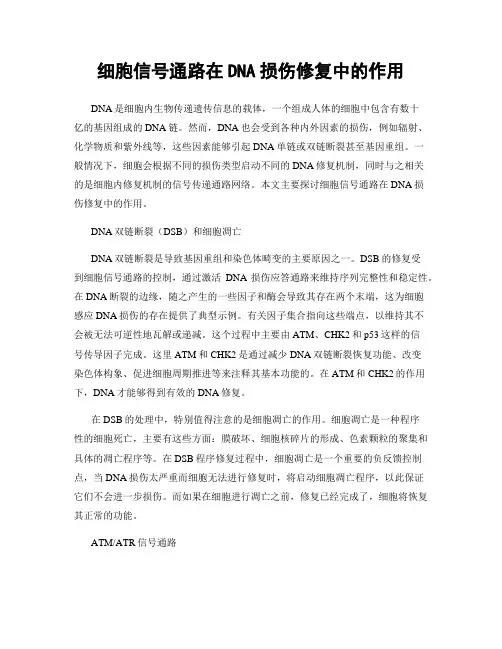
细胞信号通路在DNA损伤修复中的作用DNA是细胞内生物传递遗传信息的载体,一个组成人体的细胞中包含有数十亿的基因组成的DNA链。
然而,DNA也会受到各种内外因素的损伤,例如辐射、化学物质和紫外线等,这些因素能够引起DNA单链或双链断裂甚至基因重组。
一般情况下,细胞会根据不同的损伤类型启动不同的DNA修复机制,同时与之相关的是细胞内修复机制的信号传递通路网络。
本文主要探讨细胞信号通路在DNA损伤修复中的作用。
DNA双链断裂(DSB)和细胞凋亡DNA双链断裂是导致基因重组和染色体畸变的主要原因之一。
DSB的修复受到细胞信号通路的控制,通过激活DNA损伤应答通路来维持序列完整性和稳定性。
在DNA断裂的边缘,随之产生的一些因子和酶会导致其存在两个末端,这为细胞感应DNA损伤的存在提供了典型示例。
有关因子集合指向这些端点,以维持其不会被无法可逆性地瓦解或递减。
这个过程中主要由ATM、CHK2和p53这样的信号传导因子完成。
这里ATM和CHK2是通过减少DNA双链断裂恢复功能、改变染色体构象、促进细胞周期推进等来注释其基本功能的。
在ATM和CHK2的作用下,DNA才能够得到有效的DNA修复。
在DSB的处理中,特别值得注意的是细胞凋亡的作用。
细胞凋亡是一种程序性的细胞死亡,主要有这些方面:膜破坏、细胞核碎片的形成、色素颗粒的聚集和具体的凋亡程序等。
在DSB程序修复过程中,细胞凋亡是一个重要的负反馈控制点,当DNA损伤太严重而细胞无法进行修复时,将启动细胞凋亡程序,以此保证它们不会进一步损伤。
而如果在细胞进行凋亡之前,修复已经完成了,细胞将恢复其正常的功能。
ATM/ATR信号通路ATM和ATR信号通路是体细胞中最知名的两个DNA损伤敏感信号通路。
这两个通路是协同工作的,ATR上游是ATM和DNA-PKcs,最初被使用于DNA双链断裂的处理。
ATM和ATR的活性可以被许多不同的DNA损伤诱导,但他们对于不同损伤源的选择性还不清楚。
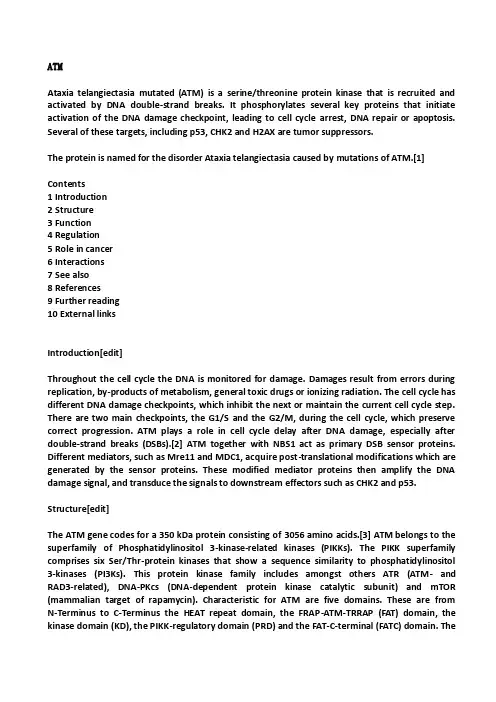
ATMAtaxia telangiectasia mutated (ATM) is a serine/threonine protein kinase that is recruited and activated by DNA double-strand breaks. It phosphorylates several key proteins that initiate activation of the DNA damage checkpoint, leading to cell cycle arrest, DNA repair or apoptosis. Several of these targets, including p53, CHK2 and H2AX are tumor suppressors.The protein is named for the disorder Ataxia telangiectasia caused by mutations of ATM.[1]Contents1 Introduction2 Structure3 Function4 Regulation5 Role in cancer6 Interactions7 See also8 References9 Further reading10 External linksIntroduction[edit]Throughout the cell cycle the DNA is monitored for damage. Damages result from errors during replication, by-products of metabolism, general toxic drugs or ionizing radiation. The cell cycle has different DNA damage checkpoints, which inhibit the next or maintain the current cell cycle step. There are two main checkpoints, the G1/S and the G2/M, during the cell cycle, which preserve correct progression. ATM plays a role in cell cycle delay after DNA damage, especially after double-strand breaks (DSBs).[2] ATM together with NBS1 act as primary DSB sensor proteins. Different mediators, such as Mre11 and MDC1, acquire post-translational modifications which are generated by the sensor proteins. These modified mediator proteins then amplify the DNA damage signal, and transduce the signals to downstream effectors such as CHK2 and p53.Structure[edit]The ATM gene codes for a 350 kDa protein consisting of 3056 amino acids.[3] ATM belongs to the superfamily of Phosphatidylinositol 3-kinase-related kinases (PIKKs). The PIKK superfamily comprises six Ser/Thr-protein kinases that show a sequence similarity to phosphatidylinositol 3-kinases (PI3Ks). This protein kinase family includes amongst others ATR (ATM- and RAD3-related), DNA-PKcs (DNA-dependent protein kinase catalytic subunit) and mTOR (mammalian target of rapamycin). Characteristic for ATM are five domains. These are from N-Terminus to C-Terminus the HEAT repeat domain, the FRAP-ATM-TRRAP (FAT) domain, the kinase domain (KD), the PIKK-regulatory domain (PRD) and the FAT-C-terminal (FATC) domain. TheHEAT repeats directly bind to the C-terminus of NBS1. The FAT domain interacts with ATM's kinase domain to stabilize the C-terminus region of ATM itself. The KD domain resumes kinase activity, while the PRD and the FATC domain regulate it. Although no structure for ATM has been solved, the overall shape of ATM is very similar to DNA-PKcs and is composed of a head and a long arm that is thought to wrap around double-stranded DNA after a conformational change. The entire N-terminal domain together with the FAT domain are predicted to adopt an α-helical structure, which was found by sequence analysis. T his α-helical structure is believed to form a tertiary structure, which has a curved, tubular shape present for example in the Huntingtin protein, which also contains HEAT repeats. FATC is the C-terminal domain with a length of about 30 amino acids. It is highly conserved and consists of an α-helix followed by a sharp turn, which is stabilized by a disulfide bond.[4]Function[edit]A complex of the three proteins Mre11, RAD50 and NBS1 (Xrs2 in yeast), called the MRN complex in humans, recruits ATM to double strand breaks (DSBs) and holds the two ends together. ATM directly interacts with the NBS1 subunit and phosphorylates the histone variant H2AX on Ser139.[5] This phosphorylation generates binding sites for adaptor proteins with a BRCT domain. These adaptor proteins then recruit different factors including the effector protein kinase CHK2 and the tumor suppressor p53. The ATM-mediated DNA damage response consists of a rapid and a delayed response. The effector kinase CHK2 is phosphorylated and thereby activated by ATM. Activated CHK2 phosphorylates phosphatase CDC25A, which is degraded thereupon and can no longer dephosphorylate CDK2-Cyclin, resulting in cell-cycle arrest. If the DSB can not be repaired during this rapid response, ATM additionally phosphorylates MDM2 and p53 at Ser15.[6] p53 is also phosphorylated by the effector kinase CHK2. These phosphorylation events lead to stabilization and activation of p53 and subsequent transcription of numerous p53 target genes including Cdk inhibitor p21 which lead to long-term cell-cycle arrest or even apoptosis.[7]ATM-mediated two-step response to DNA double strand breaks. In the rapid response activated ATM phosphorylates effector kinase CHK2 which phophphorylates CDC25A, targeting it for ubiquitination and degradation. Therefore phosphorylated CDK2-Cyclin accumulates and progression through the cell cycle is blocked. In the delayed response ATM phosphorylates the inhibitor of p53, MDM2, and p53, which is also phosphorylated by Chk2. The resulting activat ion and stabilization of p53 leads to an increased expression of Cdk inhibitor p21, which further helps to keep Cdk activity low and to maintain long-term cell cycle arrest.[7]The protein kinase ATM may also be involved in mitochondrial homeostasis, as a regulator of mitochondrial autophagy (mitophagy) whereby old, dysfunctional mitochondria are removed.[8] Regulation[edit]A functional MRN complex is required for ATM activation after double strand breaks (DSBs). The complex functions upstream of ATM in mammalian cells and induces conformational changes that facilitate an increase in the affinity of ATM towards its substrates, such as CHK2 and p53.[2] Inactive ATM is present in the cells without DSBs as dimers or multimers. Upon DNA damage, ATMautophosphorylates on residue Ser1981. This phosphorylation provokes dissociation of ATM dimers, which is followed by the release of active ATM monomers.[9] Further autophosphorylation (of residues Ser367 and Ser1893) is required for normal activity of the ATM kinase. Activation of ATM by the MRN complex is preceded by at least two steps, i.e. recruitment of ATM to DSB ends by the mediator of DNA damage checkpoint protein 1 (MDC1) which binds to MRE11, and the subsequent stimulation of kinase activity with the NBS1 C-terminus. The three domains FAT, PRD and F ATC are all involved in regulating the activity of the KD kinase domain. The FAT domain interacts with ATM's KD domain to stabilize the C-terminus region of ATM itself. The FATC domain is critical for kinase activity and highly sensitive to mutagenesis. It mediates protein-protein interaction for example with the histone acetyltransferase TIP60 (HIV-1 Tat interacting protein 60 kDa), which acetylates ATM on residue Lys3016. The acetylation occurs in the C-terminal half of the PRD domain and is required for ATM kinase activation and for its conversion into monomers. While deletion of the entire PRD domain abolishes the kinase activity of ATM, specific small deletions show no effect.[4]Role in cancer[edit]Ataxia telangiectasia (AT) is a rare human disease characterized by cerebellar degeneration, extreme cellular sensitivity to radiation and a predisposition to cancer. All AT patients contain mutations in the ATM gene (ATM). Most other AT-like disorders are defective in genes encoding the MRN protein complex. One feature of the ATM protein is its rapid increase in kinase activity immediately following double-strand break formation.[10][11] The phenotypic manifestation of AT is due to the broad range of substrates for the ATM kinase, involving DNA repair, apoptosis, G1/S, intra-S checkpoint and G2/M checkpoints, gene regulation, translation initiation, and telomere maintenance.[12] Therefore a defect in ATM has severe consequences in repairing certain types of damage to DNA, and cancer may result from improper repair. AT patients have an increased risk for breast cancer that has been ascribed to ATM's interaction and phosphorylation of BRCA1 and its associated proteins following DNA damage.[13] Certain kinds of leukemias and lymphomas, including Mantle cell lymphoma, T-ALL, atypical B cell chronic lymphocytic leukemia, and T-PLL are also associated with ATM defects.[14]Interactions[edit]Ataxia telangiectasia mutated has been shown to interact with RAD17,[15][16] RBBP8,[15][17] RAD51,[18] DNA-PKcs,[15][19] RRM2B,[20] FANCD2,[21][22] Nibrin,[15][23] TERF1,[24] BRCA1,[13][15][23][25][26][27][28] Abl gene,[18][24][29] TP53BP1,[30][31] MRE11A,[15][23] P53,[15][32][33][34][35] Bloom syndrome protein,[23][36] SMC1A[37] and RHEB.[38]199条建筑设计知识1. 公共建筑通常以交通、使用、辅助三种空间组成2. 美国著名建筑师沙利文提出的名言‘形式由功能而来’3. 密斯.凡.德.罗设计的巴塞罗那博览会德国馆采用的是‘自由灵活的空间组合’开创了流动空间的新概念4. 美国纽约赖特设计的古根海姆美术馆的展厅空间布置采用形式是串联式5. 电影放映院不需采光6. 点式住宅可设天井或平面凹凸布置可增加外墙面,有利于每层户数较多时的采光和通风7. 对结构形式有规定性的有大小和容量、物理环境、形状的规定性8. 功能与流线分析是现代建筑设计最常用的手段9. 垂直方向高的建筑需要考虑透视变形的矫正10. 橙色是暖色,而紫色含有蓝色的成分,所以偏冷;青色比黄色冷、红色比黄色暖、蓝色比绿色冷11. 同样大小冷色调较暖色调给人的感觉要大12. 同样距离,暖色较冷色给人以靠近感13. 为保持室内空间稳定感,房间的低处宜采用低明度色彩14. 冷色调给人以幽雅宁静的气氛15. 色相、明度、彩度是色彩的三要素;三元色为红、黄、蓝16. 尺度的概念是建筑物整体或局部给人的视角印象大小和其实际大小的关系17. 美的比例,必然正确的体现材料的力学特征18. 不同文化形成独特的比例形式19. 西方古典建筑高度与开间的比例,愈高大愈狭长,愈低矮愈宽阔20. ‘稳定’所涉及的要素是上与下之间的相对轻重关系的处理21. 人眼观赏规律H 18°~45°局部、细部2H 18°~27°整体3H <18°整体及环境22. 黄金分隔比例为1:1.61823. 通风屋面只能隔离太阳辐射不能保温,适宜于南方24. 总图布置要因地制宜,建筑物与周围环境之间关系紧凑,节约因地;适当处理个体与群体,空间与体形,绿化和小品的关系;合理解决采光、通风、朝向、交通与人流的组织25. 热水系统舒适稳定适用于居住建筑和托幼蒸汽系统加热快,适用于间歇采暖建筑如会堂、剧场26. 渐变具有韵律感27. 要使一座建筑显得富有活力,形式生动,在构图中应采用对比的手法对比的手法有轴线对比、体量对比、方向对比、虚实对比、色彩对比28. 要使柱子看起来显得细一些,可以采用暗色和冷色29. 巴西国会大厅在体型组合中采用了对比与协调的手法30. 展览建筑应使用穿套式的空间组合形式31. 室外空间的构成,主要依赖于建筑和建筑群体组合32. 在意大利威尼斯的圣马可广场的布局中,采用了强调了各种空间之间的对比33. 当坡地坡度较缓时,应采用平行等高线布置34. 建筑的有效面积=建筑面积-结构面积35. 加大开窗面积的方法来解决采光和通风问题较易办到36. 中国古代木结构大致可分为抬梁式、穿斗式和井干式三种37. 建筑构图原理的基本范畴有主从与重点、对比与呼应、均衡与稳定、节奏与韵律和比例与尺度38. 建筑构图的基本规律是多样统一39. 超过8层的建筑中,电梯就成为主要的交通工具了40. 建筑的模数分为基本模数、扩大模数和分模数41. 建筑楼梯梯段的最大坡度不宜超过38°42. 住宅起居室、卧室、厨房应直接采光,窗地比为1/7,其他为1/1243. 住宅套内楼梯梯段的最小净宽两边墙的0.9M,一边临空的0.75M住宅室内楼梯踏步宽不应小于0.22M,踏步高度不应小大0.20M44. 住宅底层严禁布置火灾危险性甲乙类物质的商店,不应布置产生噪声的娱乐场所45. 地下室、贮藏室等房间的最低净高不应低于2.0米46. 室内坡道水平投影长度超过15米时,宜设休息平台47. 外墙内保温所占面积不计入使用面积烟道、风道、管道井不计入使用面积阳台面积不计入使用面积壁柜应计入使用面积48. 旋转楼梯两级的平面角度不大于10度,且每级离内侧扶手中心0.25处的踏步宽度要大于0.22米49. 两个安全出口之间的净距不应小于5米50. 楼梯正面门扇开足时宜保持0.6米平台净宽,侧墙门口距踏步不宜小于0.4米,其门扇开足时不应减少梯段的净宽35. 加大开窗面积的方法来解决采光和通风问题较易办到36. 中国古代木结构大致可分为抬梁式、穿斗式和井干式三种37. 建筑构图原理的基本范畴有主从与重点、对比与呼应、均衡与稳定、节奏与韵律和比例与尺度38. 建筑构图的基本规律是多样统一39. 超过8层的建筑中,电梯就成为主要的交通工具了40. 建筑的模数分为基本模数、扩大模数和分模数41. 建筑楼梯梯段的最大坡度不宜超过38°42. 住宅起居室、卧室、厨房应直接采光,窗地比为1/7,其他为1/1243. 住宅套内楼梯梯段的最小净宽两边墙的0.9M,一边临空的0.75M住宅室内楼梯踏步宽不应小于0.22M,踏步高度不应小大0.20M44. 住宅底层严禁布置火灾危险性甲乙类物质的商店,不应布置产生噪声的娱乐场所45. 地下室、贮藏室等房间的最低净高不应低于2.0米46. 室内坡道水平投影长度超过15米时,宜设休息平台47. 外墙内保温所占面积不计入使用面积烟道、风道、管道井不计入使用面积阳台面积不计入使用面积壁柜应计入使用面积48. 旋转楼梯两级的平面角度不大于10度,且每级离内侧扶手中心0.25处的踏步宽度要大于0.22米49. 两个安全出口之间的净距不应小于5米50. 楼梯正面门扇开足时宜保持0.6米平台净宽,侧墙门口距踏步不宜小于0.4米,其门扇开足时不应减少梯段的净宽35. 加大开窗面积的方法来解决采光和通风问题较易办到36. 中国古代木结构大致可分为抬梁式、穿斗式和井干式三种37. 建筑构图原理的基本范畴有主从与重点、对比与呼应、均衡与稳定、节奏与韵律和比例与尺度38. 建筑构图的基本规律是多样统一39. 超过8层的建筑中,电梯就成为主要的交通工具了40. 建筑的模数分为基本模数、扩大模数和分模数41. 建筑楼梯梯段的最大坡度不宜超过38°42. 住宅起居室、卧室、厨房应直接采光,窗地比为1/7,其他为1/1243. 住宅套内楼梯梯段的最小净宽两边墙的0.9M,一边临空的0.75M住宅室内楼梯踏步宽不应小于0.22M,踏步高度不应小大0.20M44. 住宅底层严禁布置火灾危险性甲乙类物质的商店,不应布置产生噪声的娱乐场所45. 地下室、贮藏室等房间的最低净高不应低于2.0米46. 室内坡道水平投影长度超过15米时,宜设休息平台47. 外墙内保温所占面积不计入使用面积烟道、风道、管道井不计入使用面积阳台面积不计入使用面积壁柜应计入使用面积48. 旋转楼梯两级的平面角度不大于10度,且每级离内侧扶手中心0.25处的踏步宽度要大于0.22米49. 两个安全出口之间的净距不应小于5米50. 楼梯正面门扇开足时宜保持0.6米平台净宽,侧墙门口距踏步不宜小于0.4米,其门扇开足时不应减少梯段的净宽51. 入地下车库的坡道端部宜设挡水反坡和横向通长雨水篦子52. 室内台阶宜150*300;室外台阶宽宜350左右,高宽比不宜大于1:2.553. 住宅公用楼梯踏步宽不应小于0.26M,踏步高度不应大于0.175M54. 梯段宽度不应小于1.1M(6层及以下一边设栏杆的可为1.0M),净空高度2.2M55. 休息平台宽度应大于梯段宽度,且不应小于1.2M,净空高度2.0M56. 梯扶手高度0.9M,水平段栏杆长度大于0.5M时应为1.05M57. 楼梯垂直杆件净空不应大于0.11M,梯井净空宽大于0.11M时应采取防护措施58. 门洞共用外门宽1.2M,户门卧室起居室0.9M,厨房0.8M,卫生间及阳台门0.7M,所有门洞高为2.0M59. 住宅层高不宜高于2.8M60. 卧室起居室净高≥2.4M,其局部净高≥2.1M(且其不应大于使用面积的1/3)61. 利用坡顶作起居室卧室的,一半面积净高不应低于2.1M利用坡顶空间时,净高低于1.2M处不计使用面积;1.2--2.1M计一半使用面积;高于2.1M全计使用面积62. 放家具墙面长3M,无直接采光的厅面积不应大于10M263. 厨房面积Ⅰ、Ⅱ≥4M2;Ⅲ、Ⅳ≥5M264. 厨房净宽单面设备不应小于1.5M;双面布置设备间净距不应小于0.9M65. 对于大套住宅,其使用面积必须满足45平方米66. 住宅套型共分四类使用面积分别为34、45、56、68M267. 单人卧室≥6M2;双人卧室≥10M2;兼起居室卧室≥12M2;68. 卫生间面积三件3M2;二件2--2.5M2;一件1.1M269. 厨房、卫生间净高2.2M70. 住宅楼梯窗台距楼地面净高度低于0.9米时,不论窗开启与否,均应有防护措施71. 阳台栏杆净高1.05M;中高层为1.1M(但要<1.2);杆件净距0.1172. 无外窗的卫生间应设置防回流构造的排气通风道、预留排气机械的位置、门下设进风百叶窗或与地面间留出一定缝隙73. 每套应设阳台或平台、应设置晾衣设施、顶层应设雨罩;阳台、雨罩均应作有组织排水;阳台宜做防水;雨罩应做防水74. 寒冷、夏热冬冷和夏热冬暖地区的住宅,西面应采取遮阳措施75. 严寒地区的住宅出入口,各种朝向均应设防寒门斗或保温门76. 住宅建筑中不宜设置的附属公共用房有锅炉房、变压器室、易燃易爆化学物品商店但有厨房的饮食店可设77. 住宅设计应考虑防触电、防盗、防坠落78. 跃层指套内空间跨跃两楼层及以上的住宅79. 在坡地上建住宅,当建筑物与等高线垂直时,采用跌落方式较为经济80. 住宅建筑工程评估指标体系表中有一级和二级指标81. 7层及以上(16米)住宅必须设电梯82. 宿舍最高居住层的楼地面距入口层地面的高度大于20米时,应设电梯83. 医院病房楼,设有空调的多层旅馆,超过5层的公建室内疏散楼梯,均应设置封闭楼梯间(包括首层扩大封闭楼梯间)设歌舞厅放映厅且超过3层的地上建筑,应设封闭楼梯间。
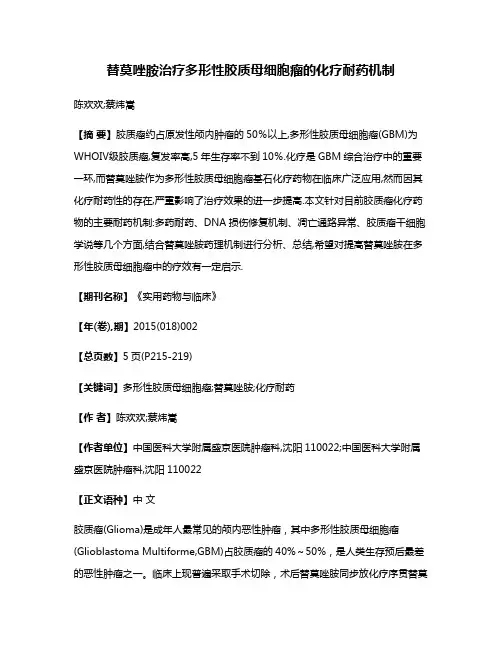
替莫唑胺治疗多形性胶质母细胞瘤的化疗耐药机制陈欢欢;蔡炜嵩【摘要】胶质瘤约占原发性颅内肿瘤的50%以上,多形性胶质母细胞瘤(GBM)为WHOⅣ级胶质瘤,复发率高,5年生存率不到10%.化疗是GBM综合治疗中的重要一环,而替莫唑胺作为多形性胶质母细胞瘤基石化疗药物在临床广泛应用,然而因其化疗耐药性的存在,严重影响了治疗效果的进一步提高.本文针对目前胶质瘤化疗药物的主要耐药机制:多药耐药、DNA损伤修复机制、凋亡通路异常、胶质瘤干细胞学说等几个方面,结合替莫唑胺药理机制进行分析、总结,希望对提高替莫唑胺在多形性胶质母细胞瘤中的疗效有一定启示.【期刊名称】《实用药物与临床》【年(卷),期】2015(018)002【总页数】5页(P215-219)【关键词】多形性胶质母细胞瘤;替莫唑胺;化疗耐药【作者】陈欢欢;蔡炜嵩【作者单位】中国医科大学附属盛京医院肿瘤科,沈阳110022;中国医科大学附属盛京医院肿瘤科,沈阳110022【正文语种】中文胶质瘤(Glioma)是成年人最常见的颅内恶性肿瘤,其中多形性胶质母细胞瘤(Glioblastoma Multiforme,GBM)占胶质瘤的40%~50%,是人类生存预后最差的恶性肿瘤之一。
临床上现普遍采取手术切除,术后替莫唑胺同步放化疗序贯替莫唑胺口服化疗为主要治疗手段。
然而,即便经积极治疗后,GBM中位生存期平均仅为14.6个月,5年生存率不到10%[1]。
除GBM恶行程度高、侵袭性生长及某些部位手术难度较大外,胶质瘤的放疗抵抗与化疗耐药也是肿瘤复发预后不良的重要原因。
有研究表明,替莫唑胺(Temozolomide,TMZ)对恶性胶质瘤的有效率约45%[2],TMZ耐药是造成GBM化疗失败的主要原因之一。
TMZ是第二代咪唑并四嗪类烷化剂,广泛应用于恶性胶质瘤和黑色素瘤中。
TMZ 口服给药,易通过血脑屏障,生物利用度高。
进入胶质瘤碱性组织中后,自动分解,其分解产物作用于肿瘤DNA,甲基化肿瘤DNA嘌呤残基—主要分为甲基化鸟嘌呤N7(70%)、O6(6%)以及腺嘌呤N3(9%)、O3,为N7-meG、O6-meG及N3-meA、O3-meA,使DNA在复制时出现碱基错配,最终致DNA双链断裂,干扰DNA合成,使肿瘤细胞G2/M期停止生长,诱导肿瘤细胞自噬或凋亡。
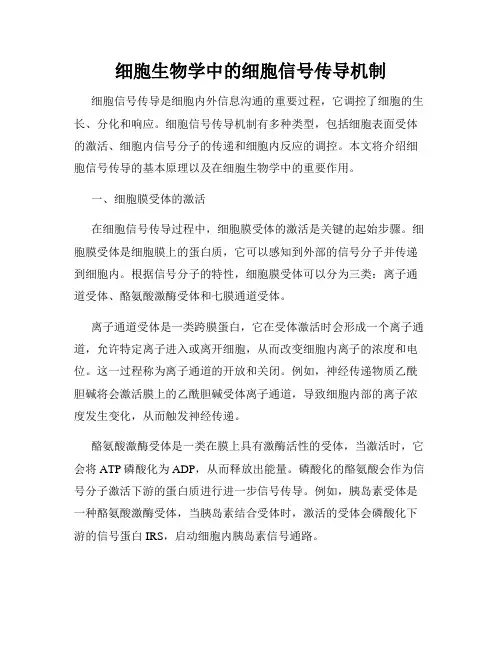
细胞生物学中的细胞信号传导机制细胞信号传导是细胞内外信息沟通的重要过程,它调控了细胞的生长、分化和响应。
细胞信号传导机制有多种类型,包括细胞表面受体的激活、细胞内信号分子的传递和细胞内反应的调控。
本文将介绍细胞信号传导的基本原理以及在细胞生物学中的重要作用。
一、细胞膜受体的激活在细胞信号传导过程中,细胞膜受体的激活是关键的起始步骤。
细胞膜受体是细胞膜上的蛋白质,它可以感知到外部的信号分子并传递到细胞内。
根据信号分子的特性,细胞膜受体可以分为三类:离子通道受体、酪氨酸激酶受体和七膜通道受体。
离子通道受体是一类跨膜蛋白,它在受体激活时会形成一个离子通道,允许特定离子进入或离开细胞,从而改变细胞内离子的浓度和电位。
这一过程称为离子通道的开放和关闭。
例如,神经传递物质乙酰胆碱将会激活膜上的乙酰胆碱受体离子通道,导致细胞内部的离子浓度发生变化,从而触发神经传递。
酪氨酸激酶受体是一类在膜上具有激酶活性的受体,当激活时,它会将ATP磷酸化为ADP,从而释放出能量。
磷酸化的酪氨酸会作为信号分子激活下游的蛋白质进行进一步信号传导。
例如,胰岛素受体是一种酪氨酸激酶受体,当胰岛素结合受体时,激活的受体会磷酸化下游的信号蛋白IRS,启动细胞内胰岛素信号通路。
七膜通道受体是一类跨膜蛋白,它在细胞膜上存在七个跨膜结构,可以感知到多种信号分子的结合。
当信号分子与受体结合时,七膜通道受体会激活膜内的G蛋白,进而启动下游的信号传导。
七膜通道受体在细胞生物学中起着非常重要的作用,例如促进视觉的视杆细胞中的视紫红质受体。
二、细胞内信号分子的传递细胞内信号分子的传递是细胞信号传导的核心环节。
当细胞膜受体被激活后,它会招募和激活一系列的信号分子,从而将信号传递到细胞内。
这些信号分子可以是离子、细胞内蛋白质、激活的酶等等。
离子信号是细胞内信号传导中最基本的形式之一,它们通过离子通道的开放和关闭来改变细胞内离子浓度和电位,从而调控细胞内的代谢和功能。
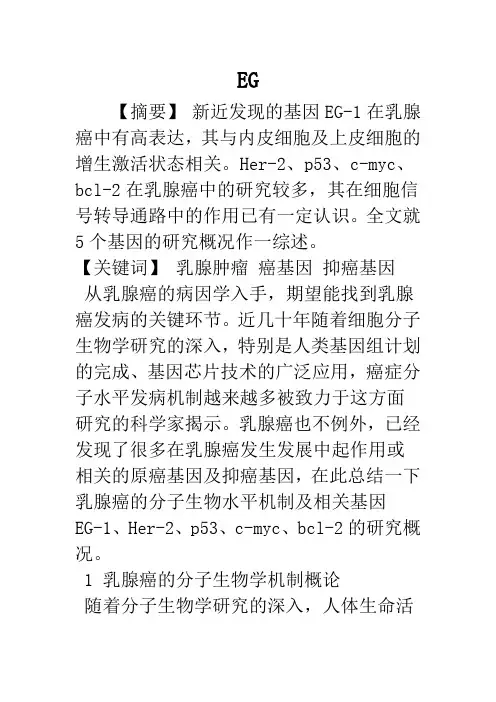
EG【摘要】新近发现的基因EG-1在乳腺癌中有高表达,其与内皮细胞及上皮细胞的增生激活状态相关。
Her-2、p53、c-myc、bcl-2在乳腺癌中的研究较多,其在细胞信号转导通路中的作用已有一定认识。
全文就5个基因的研究概况作一综述。
【关键词】乳腺肿瘤癌基因抑癌基因从乳腺癌的病因学入手,期望能找到乳腺癌发病的关键环节。
近几十年随着细胞分子生物学研究的深入,特别是人类基因组计划的完成、基因芯片技术的广泛应用,癌症分子水平发病机制越来越多被致力于这方面研究的科学家揭示。
乳腺癌也不例外,已经发现了很多在乳腺癌发生发展中起作用或相关的原癌基因及抑癌基因,在此总结一下乳腺癌的分子生物水平机制及相关基因EG-1、Her-2、p53、c-myc、bcl-2的研究概况。
1 乳腺癌的分子生物学机制概论随着分子生物学研究的深入,人体生命活动可以看成是细胞内信号转导的结果。
各种细胞因子的表达、生成、活化、细胞周期的进行等都是通过复杂的信号转导体系进行的。
目前发现的通路有很多,这些通路上的因子不是孤立作用的而是相互交织形成复杂的信号网络,而参与细胞周期调节及细胞转化的通路主要涉及到MAPK及PI-3K通路,每条通路上都有很多因子发挥着其正性或负性作用,而且相互作用、互相贯通。
乳腺癌研究中,生长因子、雌激素等促进乳腺细胞异常增生转化的机制就是通过这两条或EG-1Zhang L等于2002年在研究肿瘤条件培养液培养下的脐静脉内皮细胞对照正常情况下的脐静脉内皮细胞,发现了一种具有显着性差异的基因,他们将之命名为EG-1,该基因定位于4号染色体,编码一个178-aa,的蛋白质,其与内皮细胞、上皮细胞的增生激活状态相关,可能在肿瘤血管发生中起重要作用。
继而他们研究EG-1与实体肿瘤的相关性,表明其与乳腺癌、结直肠癌、前列腺癌有相关性,不过都是小样本,需要临床进一步的大样本证实。
他们随之继续研究EG-1可能的细胞内分子生物机制,发现其与ERK1、2,c-jun-NH2-kinase,p38的激活有关,与scr明显相关,因此考虑其可能参与了scr-MAPK途径而引起的细胞增殖效应[10]。
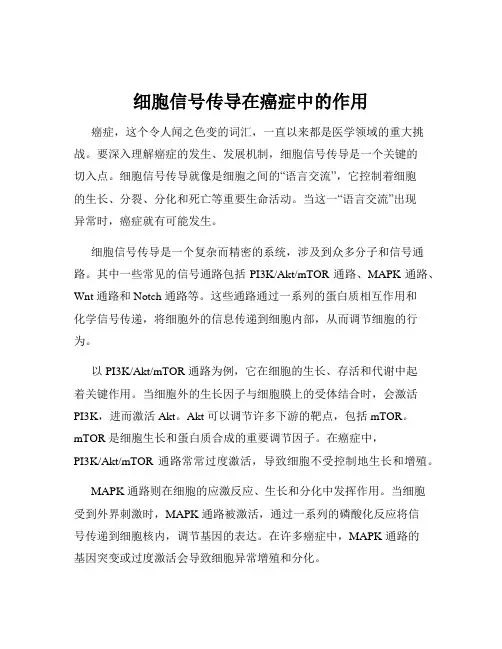
细胞信号传导在癌症中的作用癌症,这个令人闻之色变的词汇,一直以来都是医学领域的重大挑战。
要深入理解癌症的发生、发展机制,细胞信号传导是一个关键的切入点。
细胞信号传导就像是细胞之间的“语言交流”,它控制着细胞的生长、分裂、分化和死亡等重要生命活动。
当这一“语言交流”出现异常时,癌症就有可能发生。
细胞信号传导是一个复杂而精密的系统,涉及到众多分子和信号通路。
其中一些常见的信号通路包括 PI3K/Akt/mTOR 通路、MAPK 通路、Wnt 通路和 Notch 通路等。
这些通路通过一系列的蛋白质相互作用和化学信号传递,将细胞外的信息传递到细胞内部,从而调节细胞的行为。
以 PI3K/Akt/mTOR 通路为例,它在细胞的生长、存活和代谢中起着关键作用。
当细胞外的生长因子与细胞膜上的受体结合时,会激活PI3K,进而激活 Akt。
Akt 可以调节许多下游的靶点,包括 mTOR。
mTOR 是细胞生长和蛋白质合成的重要调节因子。
在癌症中,PI3K/Akt/mTOR 通路常常过度激活,导致细胞不受控制地生长和增殖。
MAPK 通路则在细胞的应激反应、生长和分化中发挥作用。
当细胞受到外界刺激时,MAPK 通路被激活,通过一系列的磷酸化反应将信号传递到细胞核内,调节基因的表达。
在许多癌症中,MAPK 通路的基因突变或过度激活会导致细胞异常增殖和分化。
Wnt 通路在胚胎发育和细胞的干性维持中具有重要意义。
在正常情况下,Wnt 信号的传递受到严格的调控。
然而,在癌症中,Wnt 通路的异常激活会导致细胞的无限增殖和肿瘤的形成。
Notch 通路参与了细胞的命运决定和组织发育。
当 Notch 受体与配体结合后,经过一系列的酶切反应,释放出 Notch 胞内段,进入细胞核调节基因表达。
Notch 通路的异常在多种癌症中都有发现,例如白血病和某些实体瘤。
细胞信号传导的异常在癌症的发生中扮演着重要角色。
首先,基因突变是导致信号传导异常的常见原因。
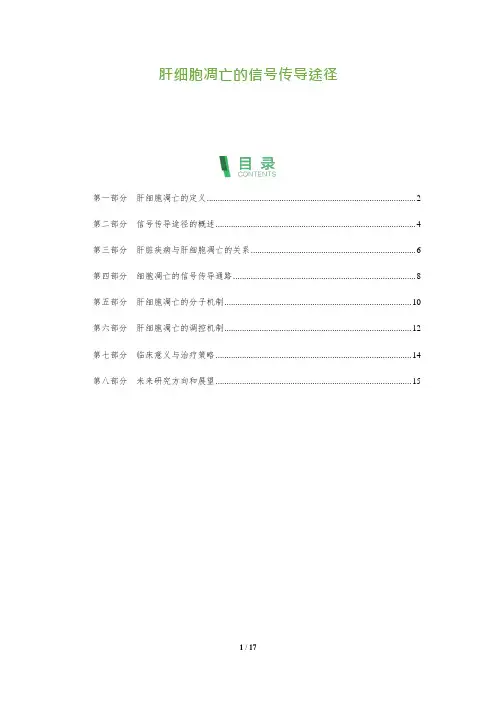
肝细胞凋亡的信号传导途径第一部分肝细胞凋亡的定义 (2)第二部分信号传导途径的概述 (4)第三部分肝脏疾病与肝细胞凋亡的关系 (6)第四部分细胞凋亡的信号传导通路 (8)第五部分肝细胞凋亡的分子机制 (10)第六部分肝细胞凋亡的调控机制 (12)第七部分临床意义与治疗策略 (14)第八部分未来研究方向和展望 (15)第一部分肝细胞凋亡的定义肝细胞凋亡是指肝细胞在某些刺激下,通过基因调控和信号传导途径触发的一种有序的、自杀性的细胞死亡过程。
该过程涉及多种内外因素以及复杂的信号传导网络。
正常情况下,肝脏具有强大的再生能力,但当受到各种损伤如病毒感染、毒素作用、免疫攻击等时,肝细胞可能会发生凋亡。
肝细胞凋亡不仅能够清除受损或功能失调的细胞,还能避免炎症反应和促进组织修复。
然而,过度或持续的肝细胞凋亡可能导致肝炎、肝纤维化甚至肝硬化等严重疾病。
因此,了解肝细胞凋亡的信号传导途径对于预防和治疗相关疾病具有重要意义。
肝细胞凋亡主要由两条信号传导途径调控:内源性线粒体通路和外源性 Fas/FasL 通路。
内源性线粒体通路的激活主要依赖于促凋亡因子如Bax 和Bad 的积累在线粒体膜上,这些因子会促进线粒体释放促凋亡因子如细胞色素 C (Cytochrome C)和 Smac/DIABLO。
随后,细胞色素 C 与 Apaf-1 结合形成凋亡复合物,进而激活 caspase-9,导致下游 caspase 级联反应的激活和细胞死亡。
另一方面,外源性 Fas/FasL 通路中,Fas 配体(FasL)与肝细胞表面的 Fas 受体结合,导致 Fas 相关的死亡域蛋白(FADD)和 caspase-8的招募并形成死亡诱导信号复合物(DISC)。
随后,caspase-8 被激活并通过下游 caspase 级联反应导致细胞死亡。
除了上述两种主要途径外,还有其他一些因素也可能参与肝细胞凋亡的调控,例如生长因子、细胞因子和氧化应激等。
精品文档细胞受体类型、特点及重要的细胞信号转导途径学院:动物科学技术学院专业:动物遗传育种与繁殖姓名:李波学号:2015050509目录1、细胞受体类型及特点 (3)1.1离子通道型受体 (3)1.2 G蛋白耦联型受体 (3)1.3 酶耦联型受体 (3)2、重要的细胞信号转导途径 (4)2.1细胞内受体介导的信号传递 (4)2.2 G蛋白偶联受体介导的信号转导 (5)2.2.1激活离子通道的G蛋白偶联受体所介导的信号通路 (5)2.2.2激活或抑制腺苷酸环化酶的G蛋白偶联受体 (5)2.2.3 激活磷脂酶C、以lP3和DAG作为双信使 G蛋白偶联受体介导的信号通路 (6)2.2 酶联受体介导的信号转导 (7)2.2.1 受体酪氨酸激酶及RTK-Ras蛋白信号通路 (7)2.2.2 P13K-PKB(Akt)信号通路 (8)2.2.3 TGF-p—Smad信号通 (8)2.2.4 JAK—STAT信号通路 (9)1、细胞受体类型及特点受体(receptor)是一种能够识别和选择性结合某种配体(信号分子)的大分子物质,多为糖蛋白,一般至少包括两个功能区域,与配体结合的区域和产生效应的区域,当受体与配体结合后,构象改变而产生活性,启动一系列过程,最终表现为生物学效应。
受体与配体问的作用具有3个主要特征:①特异性;②饱和性;③高度的亲和力。
根据靶细胞上受体存在的部位,可将受体分为细胞内受体(intracellular receptor)和细胞表面受体(cell surface receptor)。
细胞内受体介导亲脂性信号分子的信息传递,如胞内的甾体类激素受体。
细胞表面受体介导亲水性信号分子的信息传递,膜表面受体主要有三类:①离子通道型受体(ion—channel—linked receptor);②G蛋白耦联型受体(G—protein —linked receptor);③酶耦联的受体(enzyme—linked recep—tor)。
最新:ATR抑制剂抗肿瘤治疗的研究新进展摘要DNA损伤应答(DNAdamageresponse,DDR)机制包括检测DNA损伤,阻滞细胞周期和启动DNA修复。
共济失调毛细血管扩张和Rad3相关激酶(ataxiate1angiectasiaandRad3-re1ated,ATR)是DDR核心的关键激酶,负责感知复制应激(rep1icationstress,RS)并将其信号传导至S和G2/M检查点以启动DNA修复。
在肿瘤细胞中G1检查点缺失和癌基因的激活,导致癌症细胞更多进入RS增加的S期。
因此,肿瘤细胞更加依赖S和G2/M检查点,使其成为一个有吸引力的靶点。
ATR抑制剂是目前抗肿瘤药物开发的热点,部分ATR抑制剂目前已经进入临床试验阶段。
本综述旨在总结支持ATR抑制剂作为单药以及与化疗、放疗和新型靶向药物(如PARP抑制剂)联合使用的临床试验数据,并讨论目前ATR抑制剂开发和生物标志物探索中面临的挑战。
环境及细胞内多种因素都会引起DNA损伤并导致基因组不稳定。
DNA损伤应答(DNAdamageresponse,DDR)整合多种细胞调控过程,对维持基因组的稳定性和整体性都是至关重要的[1]。
在真核生物中,不同的DNA损伤引起应答蛋白的激活,这些蛋白主要包括一些超大分子量的蛋白激酶,如DNA 依赖性蛋白激酶催化亚基(DNA-dependentproteinkinasecata1yticsubunit,DNA-PKcs),共济失调毛细血管扩张突变基因(ataxiate1angiectasia-mutatedgene,ATM基因),共济失调-毛细血管扩张和Rad3-相关激酶(ataxiate1angiectasiaandRad3-re1ated f ATR)以及FanconiAnaemia复合物,这些蛋白进一步激活DNA修复,细胞周期阻滞,细胞凋亡,衰老等多个信号通路[2]。
DNA修复的过程发生在损伤位点附近的染色质区域,其过程非常复杂。
J AK 2S T AT 信号传导通路和血管平滑肌细胞段 超 综述 陈 鑫 邱志兵 审校(南京医科大学附属南京第一医院心胸外科, 江苏 南京 210006)JAK 2STAT S i gna l Tr an sducti on Pa thwa y an d Va scul a r Sm ooth M uscle CellDUAN Chao, CHEN Xin, Q I U Zhi 2bing(D epa rt m ent of Thoracic &Ca rdi ovascula r S urgery,N a nj ing F irst Hospita l Aff ilia ted to N a nj ing M edica l University , N anjing 210006, China )文章编号:100423934(2009)0621056203 中图分类号:R329.2+1 文献标识码:A 摘要: JAK 2ST AT 信号传导通路是目前心血管分子生物学研究领域的热点。
血管平滑肌细胞的增殖和迁移是血管增殖性疾病发病的核心环节。
JAK 2ST AT 信号传导通路为调控血管平滑肌细胞增殖和迁移的基因治疗提供了新的思路。
关键词: 信号传导;细胞因子;血管平滑肌细胞Ab stra ct: The JAK 2ST AT signal transduc tion pathway is the current hot s pot in molecula r 2cardi ov a scu l a r re search .Va scul a r s mooth musc l e cell proliferati on and m igration is at the core of the p r olife rati on of vascular dis ea ses .The JAK 2ST AT signa l transducti on pathway p r o 2vides a ne w way of t hinking f o r gene the rapy and the regul a tion of vascular s mooth m uscle cell p r olife rati on and m igra tion .Key wor ds: signa l transduc ti on;cytokine;vascular s mo o t h musc l e ce ll JAK 2ST AT (Janus kinase /signal tr ansducer and ac 2tivat or of transcription )信号传导通路是目前心血管分子生物学研究领域的热点。
喉鳞癌组织中SMG-1、ATM和P53的表达及临床意义周学军;王晓凤;冯勇军;谢民强【摘要】目的检测SMG-1、ATM和P53在喉鳞癌组织中的表达,探讨它们在肿瘤发生发展过程中的相互作用.方法收集2006年1月1日~2009年8月31日在耳鼻咽喉科住院手术的喉鳞癌患者标本,采用免疫组化法检测63例喉鳞癌、30例癌旁正常组织中SMG-1、ATM和P53蛋白的表达情况,并对它们的表达与喉癌临床病理特征之间的关系以及三者的相关性进行分析.结果 SMG-1、ATM和P53在喉鳞癌组中的表达率分别为36.5%(23/63)、41.3%(26/63)、和57.1%(36/63),与癌旁正常组织比较(分别为73.3%、83.3%、和20.0%),差异有统计学意义(P<0.05);SMG-1表达与T分期和原发部位呈显著相关(P<0.05),与患者年龄、N分期、病理分级无关(P>0.05).ATM和P53表达均与患者年龄、T分期、N分期、原发部位、病理分级无关(P>0.05).SMG-1阴性表达患者的五年生存率明显高于阳性患者,差异有统计学意义(P<0.05).SMG-1和P53的表达之间存在负相关关系(r=-0.476,P<0.01).结论 SMG-1、ATM和P53与喉癌的发生关系密切,SMG-1表达是反映喉癌临床病理特征和预后的重要生物学指标,其可能通过调控P53表达,共同在喉癌的发生发展中起重要作用.【期刊名称】《南方医科大学学报》【年(卷),期】2016(036)001【总页数】6页(P50-55)【关键词】生殖器形成抑制基因-1;毛细血管扩张突变基因;P53;喉癌;预后【作者】周学军;王晓凤;冯勇军;谢民强【作者单位】南方医科大学珠江医院耳鼻咽喉科,广东广州510280;海南医学院附属医院耳鼻咽喉科,海南海口570102;海南医学院附属医院耳鼻咽喉科,海南海口570102;海南省农垦总局医院耳鼻咽喉科,海南海口570311;南方医科大学珠江医院耳鼻咽喉科,广东广州510280【正文语种】中文喉癌是严重影响人类健康的疾病之一,在过去的十年间,喉癌的外科治疗技术不断更新,多种治疗方式不断改进,使得喉癌患者的喉功能保存率及生存质量获得不断提高。
细胞信号传导机制细胞信号传导机制是生物体中细胞之间相互通讯的重要方式,能够调节细胞的功能和行为。
这一机制通过信号的产生、传导和响应来实现,涉及到多个细胞组分和分子信号的相互作用与调控。
一、信号的产生细胞信号的产生可以通过多种途径实现,如内源性信号分子的释放、外源性刺激的作用以及细胞内代谢产物的积累等。
这些信号在细胞内部引发一系列的生物化学反应,并通过信号传导通路将信息传递给下游靶标分子。
1. 激活型受体信号传导细胞膜上的受体可以感知外界环境的变化,并将外界刺激转化为细胞内信号。
其中,离子通道受体、酪氨酸激酶受体和七膜片受体是常见的受体类型。
当配体与受体结合时,受体会发生构象变化,从而激活下游的信号传导路径。
2. 细胞内受体信号传导某些小分子信号物质可以直接进入细胞内部,与细胞内受体结合,触发信号传导。
典型的例子是细胞核受体家族,包含雌激素受体和甲状腺激素受体等。
这类受体通过结合到DNA上的特定序列,调控基因的转录和翻译过程。
二、信号的传导经过产生的信号需要在细胞内传播,这通常通过信号传导通路来实现。
信号传导通路是一系列的分子交互作用,将信号从上游传递到下游的靶标分子上。
常见的信号传导通路有MAPK通路、PI3K/AKT通路和Wnt通路等。
1. MAPK通路MAPK(Mitogen-Activated Protein Kinase)通路是一条重要的信号传导路径,参与调控细胞的增殖、分化和存活等过程。
该通路包括MAPKKK、MAPKK和MAPK三个级别的激酶,信号的传导是通过磷酸化链式反应实现的。
2. PI3K/AKT通路PI3K(Phosphoinositide 3-Kinase)/AKT(Protein Kinase B)通路在细胞存活和代谢调节中发挥重要作用。
当细胞受到外界刺激时,PI3K会磷酸化细胞膜上的磷脂酰肌醇,从而激活AKT,进而调控多种下游效应蛋白,如mTOR和FOXO蛋白等。
三、信号的响应信号的传导最终会导致细胞的特定生理和生化反应,即信号的响应。
ATMAtaxia telangiectasia mutated (ATM) is a serine/threonine protein kinase that is recruited and activated by DNA double-strand breaks. It phosphorylates several key proteins that initiate activation of the DNA damage checkpoint, leading to cell cycle arrest, DNA repair or apoptosis. Several of these targets, including p53, CHK2 and H2AX are tumor suppressors.The protein is named for the disorder Ataxia telangiectasia caused by mutations of ATM.[1]Contents1 Introduction2 Structure3 Function4 Regulation5 Role in cancer6 Interactions7 See also8 References9 Further reading10 External linksIntroduction[edit]Throughout the cell cycle the DNA is monitored for damage. Damages result from errors during replication, by-products of metabolism, general toxic drugs or ionizing radiation. The cell cycle has different DNA damage checkpoints, which inhibit the next or maintain the current cell cycle step. There are two main checkpoints, the G1/S and the G2/M, during the cell cycle, which preserve correct progression. ATM plays a role in cell cycle delay after DNA damage, especially after double-strand breaks (DSBs).[2] ATM together with NBS1 act as primary DSB sensor proteins. Different mediators, such as Mre11 and MDC1, acquire post-translational modifications which are generated by the sensor proteins. These modified mediator proteins then amplify the DNA damage signal, and transduce the signals to downstream effectors such as CHK2 and p53.Structure[edit]The ATM gene codes for a 350 kDa protein consisting of 3056 amino acids.[3] ATM belongs to the superfamily of Phosphatidylinositol 3-kinase-related kinases (PIKKs). The PIKK superfamily comprises six Ser/Thr-protein kinases that show a sequence similarity to phosphatidylinositol 3-kinases (PI3Ks). This protein kinase family includes amongst others ATR (ATM- and RAD3-related), DNA-PKcs (DNA-dependent protein kinase catalytic subunit) and mTOR (mammalian target of rapamycin). Characteristic for ATM are five domains. These are from N-Terminus to C-Terminus the HEAT repeat domain, the FRAP-ATM-TRRAP (FAT) domain, the kinase domain (KD), the PIKK-regulatory domain (PRD) and the FAT-C-terminal (FATC) domain. TheHEAT repeats directly bind to the C-terminus of NBS1. The FAT domain interacts with ATM's kinase domain to stabilize the C-terminus region of ATM itself. The KD domain resumes kinase activity, while the PRD and the FATC domain regulate it. Although no structure for ATM has been solved, the overall shape of ATM is very similar to DNA-PKcs and is composed of a head and a long arm that is thought to wrap around double-stranded DNA after a conformational change. The entire N-terminal domain together with the FAT domain are predict ed to adopt an α-helical structure, which was found by sequence analysis. This α-helical structure is believed to form a tertiary structure, which has a curved, tubular shape present for example in the Huntingtin protein, which also contains HEAT repeats. FATC is the C-terminal domain with a length of about 30 amino acids. It is highly conserved and consists of an α-helix followed by a sharp turn, which is stabilized by a disulfide bond.[4]Function[edit]A complex of the three proteins Mre11, RAD50 and NBS1 (Xrs2 in yeast), called the MRN complex in humans, recruits ATM to double strand breaks (DSBs) and holds the two ends together. ATM directly interacts with the NBS1 subunit and phosphorylates the histone variant H2AX on Ser139.[5] This phosphorylation generates binding sites for adaptor proteins with a BRCT domain. These adaptor proteins then recruit different factors including the effector protein kinase CHK2 and the tumor suppressor p53. The ATM-mediated DNA damage response consists of a rapid and a delayed response. The effector kinase CHK2 is phosphorylated and thereby activated by ATM. Activated CHK2 phosphorylates phosphatase CDC25A, which is degraded thereupon and can no longer dephosphorylate CDK2-Cyclin, resulting in cell-cycle arrest. If the DSB can not be repaired during this rapid response, ATM additionally phosphorylates MDM2 and p53 at Ser15.[6] p53 is also phosphorylated by the effector kinase CHK2. These phosphorylation events lead to stabilization and activation of p53 and subsequent transcription of numerous p53 target genes including Cdk inhibitor p21 which lead to long-term cell-cycle arrest or even apoptosis.[7]ATM-mediated two-step response to DNA double strand breaks. In the rapid response activated ATM phosphorylates effector kinase CHK2 which phophphorylates CDC25A, targeting it for ubiquitination and degradation. Therefore phosphorylated CDK2-Cyclin accumulates and progression through the cell cycle is blocked. In the delayed response ATM phosphorylates the inhibitor of p53, MDM2, and p53, which is also phosphorylated by Chk2. The resulting activation and stabilization of p53 leads to an increased expression of Cdk inhibitor p21, which further helps to keep Cdk activity low and to maintain long-term cell cycle arrest.[7]The protein kinase ATM may also be involved in mitochondrial homeostasis, as a regulator of mitochondrial autophagy (mitophagy) whereby old, dysfunctional mitochondria are removed.[8] Regulation[edit]A functional MRN complex is required for ATM activation after double strand breaks (DSBs). The complex functions upstream of ATM in mammalian cells and induces conformational changes that facilitate an increase in the affinity of ATM towards its substrates, such as CHK2 and p53.[2] Inactive ATM is present in the cells without DSBs as dimers or multimers. Upon DNA damage, ATMautophosphorylates on residue Ser1981. This phosphorylation provokes dissociation of ATM dimers, which is followed by the release of active ATM monomers.[9] Further autophosphorylation (of residues Ser367 and Ser1893) is required for normal activity of the ATM kinase. Activation of ATM by the MRN complex is preceded by at least two steps, i.e. recruitment of ATM to DSB ends by the mediator of DNA damage checkpoint protein 1 (MDC1) which binds to MRE11, and the subsequent stimulation of kinase activity with the NBS1 C-terminus. The three domains FAT, PRD and FATC are all involved in regulating the activity of the KD kinase domain. The FAT domain interacts with ATM's KD domain to stabilize the C-terminus region of ATM itself. The FATC domain is critical for kinase activity and highly sensitive to mutagenesis. It mediates protein-protein interaction for example with the histone acetyltransferase TIP60 (HIV-1 Tat interacting protein 60 kDa), which acetylates ATM on residue Lys3016. The acetylation occurs in the C-terminal half of the PRD domain and is required for ATM kinase activation and for its conversion into monomers. While deletion of the entire PRD domain abolishes the kinase activity of ATM, specific small deletions show no effect.[4]Role in cancer[edit]Ataxia telangiectasia (AT) is a rare human disease characterized by cerebellar degeneration, extreme cellular sensitivity to radiation and a predisposition to cancer. All AT patients contain mutations in the ATM gene (ATM). Most other AT-like disorders are defective in genes encoding the MRN protein complex. One feature of the ATM protein is its rapid increase in kinase activity immediately following double-strand break formation.[10][11] The phenotypic manifestation of AT is due to the broad range of substrates for the ATM kinase, involving DNA repair, apoptosis, G1/S, intra-S checkpoint and G2/M checkpoints, gene regulation, translation initiation, and telomere maintenance.[12] Therefore a defect in ATM has severe consequences in repairing certain types of damage to DNA, and cancer may result from improper repair. AT patients have an increased risk for breast cancer that has been ascribed to ATM's interaction and phosphorylation of BRCA1 and its associated proteins following DNA damage.[13] Certain kinds of leukemias and lymphomas, including Mantle cell lymphoma, T-ALL, atypical B cell chronic lymphocytic leukemia, and T-PLL are also associated with ATM defects.[14]Interactions[edit]Ataxia telangiectasia mutated has been shown to interact with RAD17,[15][16] RBBP8,[15][17] RAD51,[18] DNA-PKcs,[15][19] RRM2B,[20] FANCD2,[21][22] Nibrin,[15][23] TERF1,[24] BRCA1,[13][15][23][25][26][27][28] Abl gene,[18][24][29] TP53BP1,[30][31] MRE11A,[15][23] P53,[15][32][33][34][35] Bloom syndrome protein,[23][36] SMC1A[37] and RHEB.[38]。